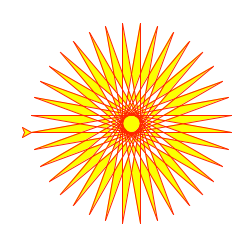turtle 로 전체화면에서 임의로 선그리기
import turtle
import random
# 화면 설정
def setup_screen():
"""창을 설정하고 전체 화면과 유사하게 최대화합니다."""
screen = turtle.Screen()
screen.setup(width=1.0, height=1.0) # 화면 크기를 최대화합니다.
screen.title("무작위 선 그리기 (전체 화면)")
screen.colormode(255) # RGB 색상 모드를 0-255로 설정합니다.
screen.bgcolor("black") # 배경색을 검은색으로 설정합니다.
screen.tracer(0) # 그리기 속도를 높이기 위해 자동 화면 업데이트를 끕니다.
return screen
# 거북이 설정
def setup_turtle():
"""선을 그릴 거북이를 설정합니다."""
t = turtle.Turtle()
t.hideturtle() # 거북이 아이콘을 숨깁니다.
t.speed(0) # 최고 속도로 설정합니다.
t.pensize(2) # 펜 두께를 설정합니다.
return t
# 무작위 색상 생성
def get_random_color():
"""무작위 RGB 색상 튜플을 반환합니다."""
r = random.randint(0, 255)
g = random.randint(0, 255)
b = random.randint(0, 255)
return (r, g, b)
# 메인 그리기 루프
def draw_random_lines(t, screen):
"""화면이 종료될 때까지 무작위 선을 계속 그립니다."""
while True:
# 무작위 색상 및 위치 설정
color = get_random_color()
t.pencolor(color)
# 펜을 든 상태로 무작위 위치로 이동 (현재 위치에서 그리기 시작)
t.left(random.randint(-180, 180)) # 무작위로 방향을 돌립니다.
# 무작위 길이만큼 앞으로 이동 (선을 그림)
distance = random.randint(50, 300)
t.forward(distance)
# 화면 가장자리를 벗어났는지 확인하고, 벗어났다면 펜을 들고 중앙 근처로 이동
# 이 과정이 없으면 거북이가 화면 밖으로 나가버려 그림이 멈춘 것처럼 보일 수 있습니다.
current_x, current_y = t.position()
screen_width = screen.window_width()
screen_height = screen.window_height()
if abs(current_x) > screen_width / 2 or abs(current_y) > screen_height / 2:
t.penup() # 펜 들기
t.goto(0, 0) # 중앙으로 이동
t.left(random.randint(-180, 180)) # 방향을 다시 무작위로 설정
t.pendown() # 펜 내리기
# 화면 업데이트 (tracer(0)를 사용했으므로 수동으로 업데이트)
screen.update()
# 프로그램 실행
if __name__ == "__main__":
screen = setup_screen()
t = setup_turtle()
try:
draw_random_lines(t, screen)
except turtle.Terminator:
# 창 닫기 버튼을 눌렀을 때 발생하는 예외 처리
print("프로그램이 종료되었습니다.")
except Exception as e:
print(f"예외 발생: {e}")
# 창을 닫을 때까지 프로그램이 대기하도록 함 (실제 draw_random_lines 루프에서는 필요 없음)
# turtle.done()'프로그래밍 > Python' 카테고리의 다른 글
| [python] 유튜브 영상 경로로 다운받기 youtube_downloader.py (0) | 2025.11.24 |
|---|---|
| [python] random walk artistic noise trail (1) | 2025.11.13 |
| [python] asciichartpy - 터미널(콘솔) 환경에 깔끔하고 읽기 쉬운 텍스트 기반의 ASCII 아트 그래프를 그려주는 라이브러리 (0) | 2025.10.22 |
| [python] Plotly를 사용한 게이지 차트 (Gauge Chart) 생성 예제 (Python Code) (0) | 2025.10.16 |
| [PYTHON] Python 3.14.0 정식 버전 출시 🐍 (0) | 2025.10.13 |


